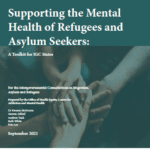This blog is for state-level actors and service providers, particularly those navigating transitions in the administration of refugee services. It explores strategies for managing change, preserving service continuity, and building organizational readiness, drawing on Switchboard’s recent conversations with several states who have successfully worked through challenging transitions.
State Refugee Programs and Change Management
As with services on the local level, state-level refugee services face ongoing challenges, such as staffing changes, funding shifts, and evolving policies. Building resilient state-level systems is critical for navigating these realities in our sector. Without careful planning, transitions can disrupt services and damage trust. But with intentional management, change can strengthen systems and improve outcomes for newcomers. State-level providers can create adaptable structures supported by strong partnerships, clear communication, and designated leads to keep services steady through change.
The strategies and tips in this blog are meant to support states planning for change, not just as a safeguard but as a core part of their service delivery models. Strong change management ensures the mission continues throughout transformation. Taking a deliberate approach can prevent service gaps, reduce staff burnout, and allow new systems to successfully take root.
Tools for Strengthening Institutional Knowledge at the State Level
Whether your state is navigating current challenges in a changing environment, building a new refugee services program, or inheriting responsibilities from a previous model, strong documentation and clear processes are essential. States with lasting infrastructure in place often credit their success to early investments in organizational readiness. Here are a few tools and approaches that can help:
- Internal knowledge manuals: These might include onboarding guides, lists of key acronyms, explanations of funding streams, or referral network maps. Think of these manuals as an evolving handbook to onboard new staff and institutionalize knowledge over time.
- Standard operating procedures (SOPs): SOPs are helpful for fidelity to recurring processes like intakes, eligibility verifications, contract monitoring, and data entry. Creating SOPs with input from current and former staff can help ensure they’re accurate and widely usable.
- Templates and toolkits: From monitoring tools to Requests for Proposal (RFP) templates, states can benefit from ready-to-use materials. Consider starting a shared drive or internal library where these resources can be accessed and updated regularly.
- Cross-training: Where capacity allows, train staff across functions. This helps ensure that institutional knowledge isn’t lost during transitions and promotes a more resilient team.
States don’t have to start from scratch. Peers, national TA providers, and already-existing models offer strong starting points that can be adapted to local contexts. What’s most important is taking a proactive, iterative approach to documentation and internal systems.
Tips from the Field: Insights from State-Level Actors
State-level newcomer services work within a wide range of contexts, shaped by factors like political climate, geographic scale, existing social services infrastructure, and histories of refugee resettlement. Regardless of how your state administers newcomer services, navigating change and transition is a shared challenge, and there is value in learning from the varied experiences of others. Here are a few practices that many states have found helpful:
- Start with a mapping exercise: One state began their transition by mapping out all existing providers and Refugee Support Services (RSS)-funded activities in their state—even if they weren’t directly overseeing them yet. This helped them identify service gaps, assess capacity, and build relationships with the right partners.
- Embed services in ways that work for your state: In some cases, refugee services have found a home in larger systems—such as workforce development or social services departments—that provide complementary services to RSS or other ORR grants. Planning these connections strategically can unlock access to existing systems, databases, and other resources.
- Engage staff at multiple levels: In Georgia, for example, efforts to centralize systems for newcomer services coordination included not just program directors but also front-line staff. This helped ensure new systems were practical and relevant to day-to-day work.
- Anticipate what’s coming: Providers in several states emphasized the importance of staying proactive and thinking beyond initial infrastructure. Long-term sustainability should include succession planning, strong data systems, and plans for securing future funding opportunities.
Additional Resources for States Navigating the Path Ahead
No matter your state context, you don’t have to navigate this work alone. Switchboard is working hard to continue capturing and sharing lessons like these in a number of upcoming learning opportunities, including through a new office hours series that will launch in September 2025. In the meantime, the following tools and insights can support your team in preserving continuity, building internal readiness, and learning from peers to strengthen state-level refugee services for the long term.
- Archived Webinar: Using Data for Strategic Consultation and Community Connectedness (2024)
- Blog: Three Ways to Preserve Institutional Knowledge for Successful Change Management in Resettlement (2024)
- Blog: Refugee Quarterly Consultations: Innovative Models for Empowering Community Connections (2024)
- Podcast: Leading During Times of Transition (2023)









